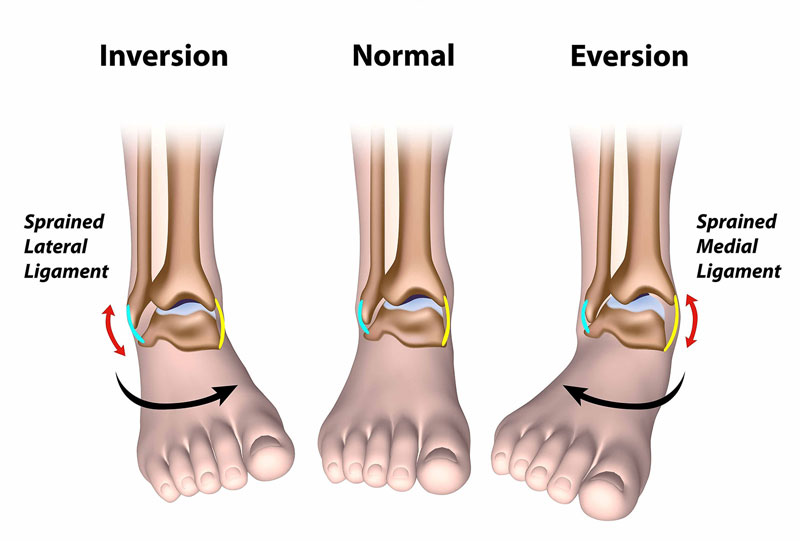A sprained ankle is an injury to the hard tissue bands or ligaments that surround the bones of the foot and connect them to the foot. This injury usually occurs when the ankle is accidentally twisted or rotated incorrectly. This can stretch or tear the ligaments that hold your ankle bones and joints together.
All ligaments have a specific range of motion that allows them to stabilize joints. When the ligaments around the ankle cross these boundaries, it causes a sprain. Ankle sprains usually involve damage to the ligaments outside the ankle.
What causes a sprained ankle?
Ankle sprains often occur when the foot suddenly twists or turns. This rotation causes the ankle joint to move out of its normal position. Sometimes due to a sudden or unexpected movement during physical activity, the ankle may twist inward. This sprain causes a stretch or tear of one or more ligaments around the ankle.
As a result of this tear, swelling or bruising may occur around the wrist. You may also feel pain or discomfort when putting weight on the affected area. Of course, tendons, cartilage, and blood vessels may also be damaged due to sprains.
Ankle sprains can happen to anyone at any age. Exercising, walking on uneven surfaces, or even wearing the wrong shoes can cause this type of injury.
Symptoms of a sprained ankle
If you see the following symptoms in your ankle, you may have sprained ankle:
• swelling
• to soften
• a bruise
• the pain
• Inability to bear weight on the injured ankle
• Change in skin colour
• Hardness
The ankle can sustain different types of injuries. When you have a problem in the ankle area, it is better to see a doctor because the doctor can determine if the damage to your ankle was a sprain or if you have suffered a more severe injury.

by physiotherapy
How is sprained ankle treated?
Ankle sprains can be treated like any other problem. Treating a sprained ankle will help you heal and prevent further discomfort. The injured area mustn’t bear weight while your ankle is healing.
A) Home remedies
In some cases, you may be able to treat mild ankle sprains at home. Recommended home remedies include the following:
• Use elastic bands (such as ACE bands) to wrap around the ankle
• But note that these straps should not be tied too tightly!
• Tie an ankle strap to support the ankle
• Use of crutches if needed
• Elevate your leg with a pillow to reduce swelling
• Taking pain relievers such as ibuprofen or acetaminophen to control pain
• Sufficient rest and not putting weight on the ankle
• Apply ice to the injured area as soon as possible to reduce swelling
If you use ice to reduce swelling, remember that on the first day, you need to apply ice to the affected area 3-4 times during the day for 20-30 minutes each time. After that, for the next two days, use ice every three to four hours to reduce inflammation.
B) Surgery
A sprained ankle may rarely require surgery. But surgery may be the best solution if the damage to the ligaments is severe. Also, if there is evidence of ankle instability or when the damage done to the ankle does not improve with non-surgical treatment, surgery becomes necessary. Ankle surgery is performed in two ways:
Arthroscopy
During arthroscopy, the surgeon looks inside the joint to see if there are loosely attached or completely damaged pieces of bone or cartilage.
Rebuilding
For reconstructive surgery, the surgeon repairs the torn ligament with stitches. It may also use other ligaments or tendons around the foot or ankle to repair damaged ligaments.
The type of surgery required depends on the severity of the ankle sprain and the person’s activity level. After surgery, rehabilitation plays an influential role in the recovery process. To restore movement and strengthen the ankle muscle, continuous visits by the doctor should be made, and the person should have complete physical therapy exercises. Depending on the extent of the ankle sprain and the type of surgery, rehabilitation may take weeks or months.
The long-term outlook for a person with an ankle sprain
In most cases, ankle sprains do not cause serious problems and can be completely cured with proper treatment. The length of time required for full recovery also depends on the severity of the sprain. Ankle sprains usually take a few weeks to heal. However, more severe sprains may take months to heal.
Although the pain and swelling will eventually disappear, the injured ankle may not be as strong as a healthy ankle. Your doctor may suggest specific exercises to strengthen the muscles around the ankle. But all these exercises should be done under the supervision of a doctor.

Diagnosis of a sprained ankle
If your foot is sprained, your doctor can determine which ligaments are torn by performing a physical examination. It may be necessary for the doctor to move the ankle joint in different ways during the examination so that your range of motion is carefully checked.
Various imaging tests such as x-rays can also be done to make sure that your bone is broken or not. If the doctor suspects a fracture, serious damage to the ligaments or damage to the surface of the ankle joint, he may request an MRI. An MRI scan uses a strong magnetic field and radio waves to create detailed images of the body. This allows the doctor to make a proper diagnosis.
How to prevent ankle sprains?
- Wrapping the injured ankle in an elastic bandage
- Use a wristband if necessary
- Doing strengthening exercises
- Avoid wearing high heels
- Warming up the body and legs before exercise
- Wearing sturdy and quality shoes
- Pay attention to the surfaces you walk on
- Slowing down or stopping your activities when you feel tired
An important point that should always be taken into account is that ankle sprains if left untreated, can lead to long-term pain and instability in the ankle. Therefore, it is better not to skip these pains.





